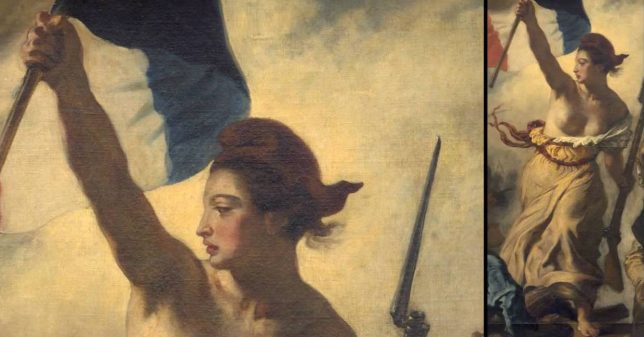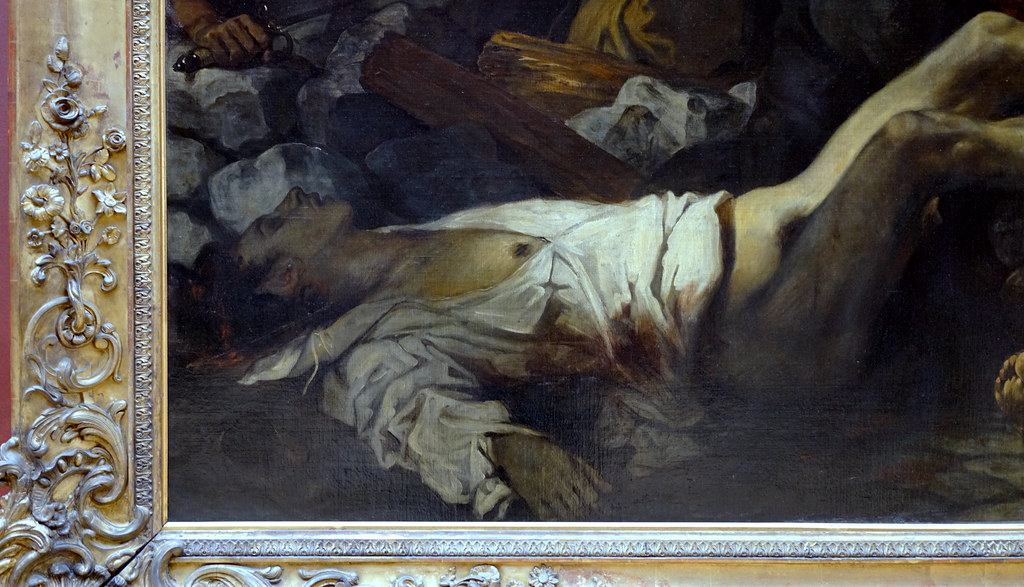Why Is Liberty Leading the People by Eugene Delacroix Considered an Example of Romantic Art

Liberty Leading the People was painted in 1830 past Eugene Delacroix right after the revolutionary effervescence that had swept across Paris that same year. Characterised past its emblematic and political significance, this big oil on canvas has become a universal symbol of liberty and republic. Often used in popular culture to symbolise people'due south emancipation from oppressive domination, it is one of the nearly famous paintings in Art History. Artsper helps yous to come to grips with the history and symbolism behind this iconic artwork.
Historical Context

The revolution depicted in this painting is not to exist confused with the 1789 French Revolution. Delacroix was inspired past the events of the July Revolution (known as Les Trois Glorieuses" (Three Glorious Days) in French), a political upheaval that took place in Paris on the 27th, 28th, and 29th of July 1830. These vehement demonstrations took place as the ruling French King Charles X tried to restrain the liberty of the people by executing a constitutional takeover. Parisians violently protested against the abuses of their individual rights. Rioters took concur of the city and violent fighting ensued, resulting in a high decease price. Charles Ten eventually abdicated and a constitutional monarchy, the July Monarchy, was established with Louis-Philippe I being made King of the French.
Delacroix wasn't much of a revolutionary himself and did non take part in the Paris fighting, just rather divers himself as a "simple stroller." Equally he wrote in a letter to his brother; "A unproblematic stroller like myself ran the same risk of stopping a bullet as the impromptu heroes who advanced on the enemy with pieces of iron fixed to broom handles." However, he advocated for liberalism and was struck by a feeling of patriotism and pride as he observed his boyfriend citizens fighting.
Romanticism

Eugene Delacroix was the leading figure of the French romantic school. He wished to emancipate himself from bookish art's classical platonic and canons. The subject of the painting was a contemporary one, whereas canvases of this size were generally reserved for historical paintings, at least co-ordinate to the rules of the hierarchy of genres of the Academy. Delacroix stated that he has "undertaken a modern subject, a barricade, and although I may non take fought for my country, at least I shall have painted for her. Information technology has restored my adept spirits." The painter also uses reds and blues, which result in stark contrasts, instead of the more muted colours that were used at that time.
Details: Freedom

At the heart of the painting, the emblematic delineation of Liberty draws the eye immediately. Represented as Marianne, a symbol of the Republic, the adult female coiffed with a Phrygian cap (a nod to the sans-culottes of the French revolution) is leading a group of revolutionaries. Her draped yellow dress reveals her breast and recalls the Greek goddesses of Antiquity. Her profile, a straight nose, plump lips, and a frail chin are reminiscent of Antiquarian Greek and Roman statues. She is a tribute to Ancient Greece, the cradle of republic, as well every bit to the Roman republican tradition. However, Delacroix mixes in mod symbols as she holds the tricolour flag in 1 hand, and a bayonet in the other. This fashion, Liberty embodies both the mod struggle and Artifact'southward ideology of liberty.
The painting's pyramidal construction heightens the fighting's momentum. The ground is strewn with bodies and, out of the misery and pain, Liberty stands alpine on the remains of a barricade, emerging strong and victorious. This rigorous limerick contains and balances the painter'southward impetuous brushstrokes and creates a hitting lighting effect. It is a scene of chaos and energy, filled with smoke and movement, and even so Delacroix's pyramid successfully creates a sense of order. The painting recalls Gericault's Raft of the Medusa, that represents violence without idealising information technology.
Details: Foreground
In the foreground, there are two notable figures. On the left, there is a man with a pistol tucked into his belt, he wears a shirt merely no jacket. His outfit indicates that he is a member of the lower class, and the cockade on his cap proves his revolutionary leanings. The figure right next to the worker wears a conservative outfit: complete with a meridian hat, jacket and vest. Delacroix clearly suggests that people of all classes came together to fight for a better guild. The revolution was not nearly 1 class fighting another, but information technology was about the people rallying against royalist oppression.
On the right side of the canvas, at that place is a young boy, who seems rather wild as he holds not one simply two pistols. He is the symbol of youthful insurgents, and his velvet cap and satchel signal that he is a schoolboy. He may accept been an inspiration for the character of the street urchin Gavroche in Victor Hugo's novel Les Miserables.

The dead bodies of soldiers and citizens on the footing represent the terrible costs of the revolution.These are best summed up by the effigy on the left corner, who is nude from the waist down and wears only a nightshirt, implying perhaps that royalists had dragged him from his bed to impart on him a terrible fate. The torso is the very close to the viewer, invading our immediate vision.
The painting was purchased by Rex Louis-Philippe to demonstrate his support of Republican values. Nonetheless, information technology was returned to Delacroix in 1939 because the revolutionary ideologies behind the painting became perceived equally dangerous and potentially inflammatory. A good reminder of how politicised fine art was in nineteenth century France.
You may too like…
Source: https://blog.artsper.com/en/a-closer-look/art-analysis-liberty-leading-the-people-by-eugene-delacroix/
0 Response to "Why Is Liberty Leading the People by Eugene Delacroix Considered an Example of Romantic Art"
إرسال تعليق